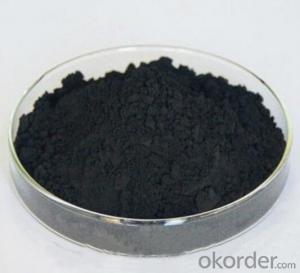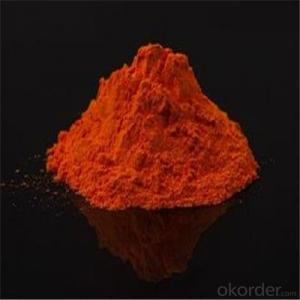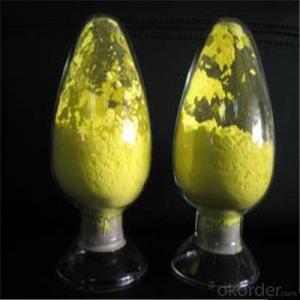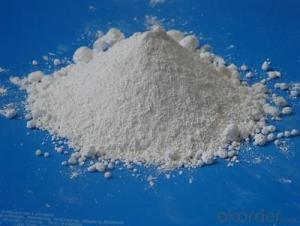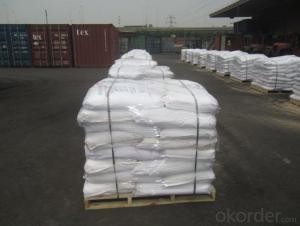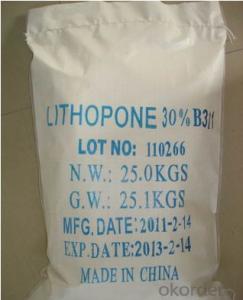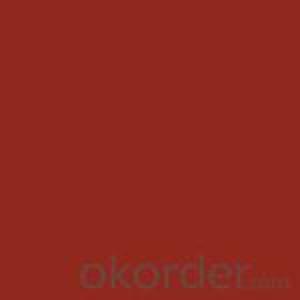Paint pigment white lithopone powder painted strength factory direct
- Loading Port:
- Tianjin
- Payment Terms:
- TT OR LC
- Min Order Qty:
- 20 m.t.
- Supply Capability:
- 2000 m.t./month
OKorder Service Pledge
OKorder Financial Service
You Might Also Like
Specifications of lithopone pigments for plastic
lithopone pigments
1,good quality and reasonable price
2,free sample
3,SGS,BV,CIQ inspection.
Pigment chemical lithopone pigments for plastic
1. Product name: Lithopone
2. Chemical formula: ZnS+BaSO4
3. Other Names:Barium zinc sulfate
4. CAS No.: 1345-05-7 H.S. Code: 3206421000
5. EINECS: 215-715-5
Appearance: A white, odorless powder. Insoluble in water. It’s has good whiteness and envelop ability.
6. Properties: This product is a kind of new-style nontoxic. Green non-pollution, lithopone than traditional lithopone albedo high, hiding power, fineness and high-temperature weatherability, strong characteristic.
7. Application: Mainly used of coatings, printing ink, rubber, plastic, powder, profiles, paint, paper, and leather, etc.
8. Package:25kgs/PP bag,25MT/20’FCL
Technology Data:
ITEM | Specification | |
B311 | B301 | |
Total Zinc and Barium Sulphate %≥ | 99.0 | 99.0 |
Zinc Sulfide Content %≥ | 30.0 | 28.0 |
Zinc Oxide Content %≤ | 0.3 | 0.6 |
Tinter Reducing Power, Compared with Standard Samples ≥ | 105 | 100 |
105°C Volatile matter %≤ | 0.3 | 0.3 |
Water solubles %≤ | 0.3 | 0.4 |
Water suspension Ph-value | Neutral | 6.0-8.0 |
Oil absorption,g/100g≤ | 6.0-8.0 | 14 |
Residue on sieve 45um %≤ | 5 | 5 |
9. Payment: T/T, L/C
10. Packing picture:


- Q: I need to find powdered paint or pigment that I can throw, for some photographs.Preferably cheap, and that wouldn't stain skin.I've looked into powder paint, though this tends to stain skin for about a week.Thanks :)
- Smash up sidewalk chalk.
- Q: Why do plants contain so many pigments?
- Chlorophyll is the respond and here is why - this pigment provides flowers their relative eco-friendly shade because of the fact flowers undergo photosynthesis to furnish themselves with glucose for capacity. in this technique, flowers soak up photograph voltaic capacity from the sunlight. Chlorophyll has a eco-friendly pigment for the reason that's the pigment that attracts photograph voltaic capacity the main effectively. consequently offering the plant with greater photograph voltaic capacity, which would be converted into chemical or warmth capacity by way of cellular respiratory, yet that's an entire distinctive tale.
- Q: Can some one suggest chemical pigments that can be easily made from chemicals available in a chemistry lab for a project?I need the name of the pigment, reactants required and chemical equations of reactions involved.I need atleast 5 pigments
- Typical pigments: carbon black (charcoal) titanium dioxide red iron oxide white lead cadmium red cadmium orange cadmium yellow
- Q: what are the accessory pigments in plant photosynthesis?
- This Site Might Help You. RE: what are the accessory pigments in plant photosynthesis?
- Q: how are pigments classified?
- What do you mean?
- Q: PLEASE TRY!, to awnser ANY of the questions below.~What factors cause leaves to change colors. Where do these colors come from?~What are the names of the specific chemical pigments that cause the colors we see (reds, yellows, purples, browns, greens etc.) These are the same pigments (chemical that causes color) that give fruit their different colors.~What is the process (how it happens) that cause leaves to fall off of the branches. Explain at the cell level. (picture)Please try to awnser. Thanks.
- Chlorophyll leaves and Tannin enters,depends on the temperature and seasons
- Q: i bought the new neon pro pigments from mac , well 5 out of the six and i also bought 'basic red'i want to use these as eye shadows but i dont know howi also bought mac mixing medium for face and body but lol , i dont know how to use any of this stuffwhat can i do to use this stuff i mean will it turn out like regular eyeshadow if i use it right? will there be a shine to it? it will reduce fall out? should i put the mixing medium on my eye first , then let dry?do i need to possibly press the pigments in a pot with some kind of eye shadow liquid?i also bought the mascara mixing medium but want to know exactly what to do with thatand also , can i mix any of the pigments with lipgloss?http://cn1.kaboodle /hi/img/2/0/0/119/a/AAAAAlrx1LUAAAAAARmgiA.jpg
- For MAC pigments you need a thick natural base underneath them to make them hold, and shine amazingly... I use paint pot base. Use a stiff eye brush and dab it in the pigment container. before applying it on your eye, shake off the access of it. make sure you have a base underneath though!
- Q: I was intrested in buying some pigments on ebay but they dont say the name they just say these nubers #68 #69 #93 do u no what pigment name they are u could serch it that might help thank you
- All mac pigments have a specific name and i had researched a bit and seen videos of people comparing the fake to the authentic pigments. I've seen fakes with a no. on it. Stay away from this seller and i strongly suggest buy it from a MAC store as most brushes, pigments, eyeshadows are fake on Ebay.
- Q: HW HELP THIS IS COMLPCATED
- Pigments in plants color every part: red rose, orange carrot, purple plums. These pigments are not photosynthetic their function varies with location in the plant and the season. Chlorophylls are the primary photosynthetic pigment class found in chloroplasts. Flavonoids like the anthocyanins provide red, blue, purple, or magenta color to flowers and fruits. Color serves to attract pollinators and seed distributors. Recent literature reports some 550 different anthocyanins.
- Q: What happens to the yellow pigments in a leaf during the summer months?
- in case you may surely ask a query like that, then it sounds to me such as you opt to have intercourse with one in all your instructors. enable me be the 1st to tell you that it will no longer take place! She's/he's have been given a husband/spouse to do each and all the grimy paintings for her/him! you're basically a pupil and that's a criminal offense in each and each state for a instructor to have something for a minor! Have had a weigh down on a instructor, definite that's a load of bull-****, yet that's the way life is and we the two might desire to provide up dreaming and locate ourselves a hoe which will please us in each way conceivable! that's effective to appreciate that somebody else has wandered that. % me as suited answer on account which you and that i've got lots in worry-loose!
Send your message to us
Paint pigment white lithopone powder painted strength factory direct
- Loading Port:
- Tianjin
- Payment Terms:
- TT OR LC
- Min Order Qty:
- 20 m.t.
- Supply Capability:
- 2000 m.t./month
OKorder Service Pledge
OKorder Financial Service
Similar products
Hot products
Hot Searches
Related keywords














